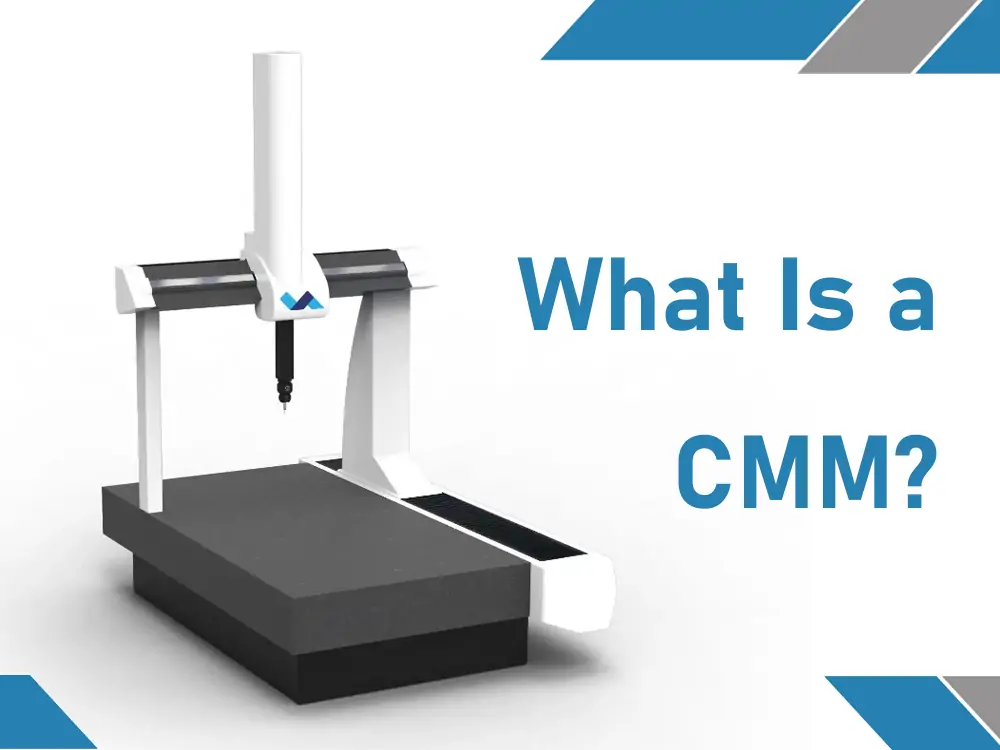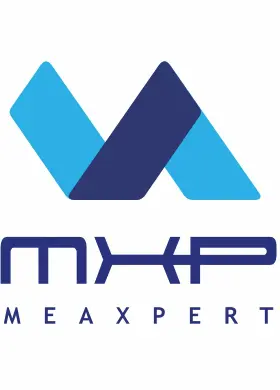
What is a Coordinate Measuring Machine?
A coordinate measuring machine is a specialized industrial device that measures an object’s geometric properties. Its main application is in the manufacturing of machine parts, where it verifies that the finished product corresponds to the design plan. Therefore, it is useful in product inspection, GD&T measurements, and dimensional analysis.
Coordinate measuring machines analyze objects by placing them in a 3-dimensional coordinate system. A probe touches the object at the specific points that need to be measured, precisely determining the distance between them. CMMs are vital in industries that require precise 3D measurements, as traditional tools like vernier calipers and optical comparators cannot perform such tasks. They are responsible for critical automotive, aerospace, medical, and defense applications.
Advantages of Coordinate Measuring Machines
The main advantage CMMs provide compared to traditional measurement machines is 3D measurement. By precisely determining 3-dimensional parameters like distance, angularity, circularity, and parallelism, CMMs are invaluable inspection tools. Another way in which they differ from traditional measurement tools is by using virtual lines and virtual points. These techniques are essential for measuring 3D objects like machine parts. CMMs can also perform surface inspections and geometric tolerances.
What are the Different Types of CMMs?
CMMs differ in the size of the parts they analyze and their operation. All CMMs have four main parts: a bridge, touch probes, a stage, and a controller. This section will discuss the details of different types of CMMs.
Bridge CMM
The bridge type CMM is the most common variant. It consists of a standing frame that slides over a flat stage area. The frame has two vertical beams at the sides of the table and a horizontal beam that stretches across it. The contact probe is suspended vertically over the horizontal beam. The probe is capable of vertical movement that measures the z-coordinate. The probe can also move across the beam, representing the y-coordinate. Finally, the movement of the frame itself denotes the x-coordinate.
The bridge CMM is highly accurate and is ideal for measuring small to medium-sized machine parts. It can measure engine and body parts in automotive workshops, medical equipment, and manufacturing components.
Gantry CMM
The body of the Gantry CMM contains two rectangular frames on either side of the stage area. A horizontal beam stretches across these frames and slides back and forth with the help of a servo motor. The probe extends downwards on an arm attached to the horizontal beam. The movement of the beam, arm, and probe facilitates the measurement of three dimensions.
Gantry CMMs have the largest body of all types. For larger versions, the stage area may be on the ground. Gantry CMMs provide a large volume in the working area. They inspect large machinery like automobile parts, CT scanners, and aircraft propellers. They are also used in the manufacturing and consumer goods industries to analyze large machine parts.
Cantilever CMM
The Cantilever CMM has a rectangular frame on one side of the table, containing a guide rail at the top. The horizontal crossbeam travels on this guide rail, representing the x-coordinate. The support arm containing the probe travels the crossbeam, measuring the y-coordinate. Finally, the probe strut extends vertically, determining the z-coordinate. It gets its name from the crossbeam that stretches over the stage area.
Due to its three-sided open structure, the Cantilever CMM is highly accessible. It is suitable for small to medium-sized workpieces and provides excellent accuracy. It is also ideal for automated working, providing easy loading and off-loading accessibility. Due to its compact nature, its conventional application is to inspect small and complex parts, gauges, and master parts.
Portable Measuring Arm CMM
Portable Measuring Arms (CMMs), also called articulated arms, are mobile CMMs that can measure tiny to large parts. Unlike traditional CMMs, portable arm CMMs model the human arm with a shoulder, elbow, forearm, and wrist. They can be moved around in the workshop and brought to the workpiece that needs inspection.
Due to their portability, Portable Arm CMMs are highly convenient. They can cover a wide range of use cases for any workshop. They provide easy and accurate measurements and support numerous axis configurations. Portable Arm CMMs range in size from less than a meter to more than four meters. They implement product inspection in the aviation, aerospace, and military industries.
Optical CMM
Optical CMMs employ an optical lens, camera, and computer software to capture and process the image of a workpiece. Therefore, the measurement is carried out primarily by software, not hardware. Due to this, Optical CMMs are also known as non-contact measurement devices. An Optical CMM can also consist of additional components like a CMOS sensor, telecentric lens, and illumination module. They are highly efficient machines with fast measurement speeds.
Due to their non-contact measurement technique, Optical CMMs are ideal for analyzing delicate or deformable workpieces like wax molds. They are also well suited for automated workstations and factories with high output requirements. Optical CMMs can perform surface analysis like flatness measurement, temperature profile, and contour work. They measure the characteristics of small and deformable parts in the electronics, medical, and plastic industries.
Coordinate Measuring Machine Accessories
In addition to the fundamental components, CMMs have several customizable add-ons that supplement their performance. These accessories enable more features on the CMM and help workshops meet special requirements.
Stylus/Probe Tip
The probe is a common component in all Coordinate Measuring Machines. A CMM probe can use direct contact, laser, or optical lenses to record measurements. The most commonly found probe tip consists of a hard spherical end made from steel or ruby. CMM probes rely on a touch-trigger mechanism that allows them to sense coordinates upon contact with the object’s surface. Modern CMM probing systems make use of up to 5 axes. Probes can be simple top-down triggers or motorized to support different angles. Tactile probes can drag along the surface of the object and record observations continuously. They are highly beneficial in surface inspection.
Granite Table
The granite table used in the stage area of the CMM acts as the base for measurements. Its purpose is to provide a flat and even surface to clamp workpieces. Granite stone tables are durable and robust, which is necessary to handle the weight of heavy machine parts and workpieces.
Fixtures
Fixtures are necessary in CMMs to ensure that the workpiece does not displace during measurement. In high-precision operations, the slightest movement can lead to enormous observational errors. Common types of CMM fixtures are clamps, fixing plates, and holding magnets.
Air Compressors and Dryers
A compressed air supply drives CMM operation. The air supply system is comprised of a compressor, filter, dryer, pressure tank/reservoir, and controls. Compressed air levels must be monitored consistently, as improper supply can damage the CMM.
Software
Modern CMMs rely on software to conduct measurements. Software tools have made the process of product inspection much simpler. Most CMM software does not require the knowledge of any programming language. Distance calculation and geometric analysis are done via a user-friendly interface on a CAD model. The control station, which houses the CMM software, requires a modern computer with an up-to-date operating system and the requisite hardware components.
How to Use a Coordinate Measuring Machine
In this section, we will go over some fundamental preparatory actions that need to be taken for successful CMM operation.
Stylus Calibration (Probe Calibration)
With continuous use, the stylus – or probe tip – of a CMM can lose its accuracy. Timely maintenance and regular calibration ensure that the CMM performs at an optimal level. Probe calibration involves measuring distances on a predefined object known as an artifact. The dimensions of the artifact are known, and the distance recorded by the CMM during calibration is compared to the actual values. For most CMMs, the artifact is a spherical object. If the reported distances are not accurate, the various parts of the CMM can be subjected to maintenance and adjustments until the calibrated values are acceptable.
Handling Precautions
Before using the CMM, always make sure that the working area and probes are free from foreign objects & debris (FOD). Similarly, you want to ensure that the arms of the CMM are moving smoothly on the guide rails. Some objects tend to expand or contract in differing temperatures; therefore, allowing time for the workpiece to adjust to the room temperature is suggested. You also want to ensure that the probe contacts the object at a constant speed for tactile measurements.
Maintenance and Calibration
With continuous use over long periods, CMMs tend to lose their accuracy. Your machine will require maintenance and calibration to perform at 100%. CMM maintenance involves inspection and repair of all moving and stationary parts, joints, screws, motors, and controllers. CMM calibration undertakes an overall accuracy check by measuring an artifact of known dimensions. According to the calibration results, the CMM may be subjected to another round of maintenance or approved for operation.
Coordinate Measuring Machine (CMM) Operator Training
CMMs are complex devices that require skilled operators. CMM operators are trained metrology technicians proficient in programming, debugging, and industrial administration. Operators need to be familiar with all the working parts of the CMM. They must be able to efficiently complete tasks with the CMM and be aware of all operational protocols. Operator training also demands knowledge of the controller and the software tools used for geometrical analysis.
Conclusion
Investing in a Coordinate Measuring Machine involves many steps, but we are here to make the journey comfortable. As long as you know your requirements, a little bit of professional guidance can help you accomplish your goals. The primary factors affecting your CMM choice are output requirements, part size, accuracy, and repeatability. Support and service options are also important factors when choosing CMMs. Regular maintenance and calibration not only extend the lifetime of a CMM but are necessary for its optimal performance. Contact us for a professional consultation on CMMs. We will be more than happy to assist you!
